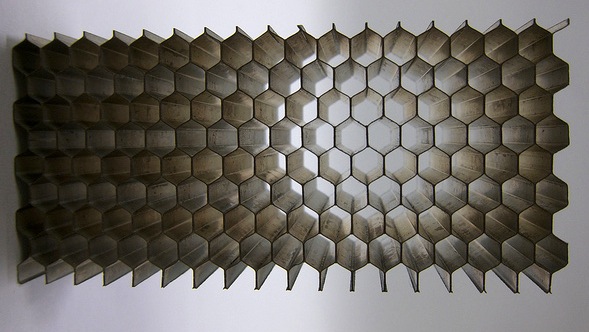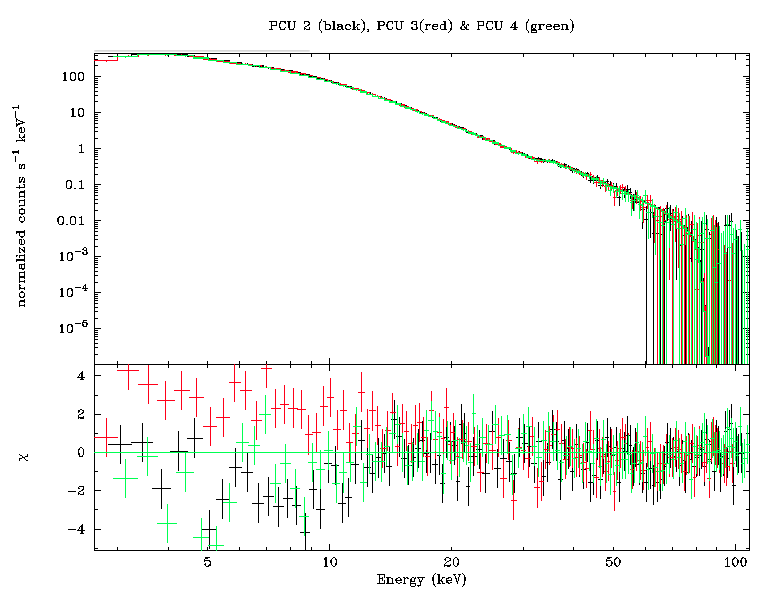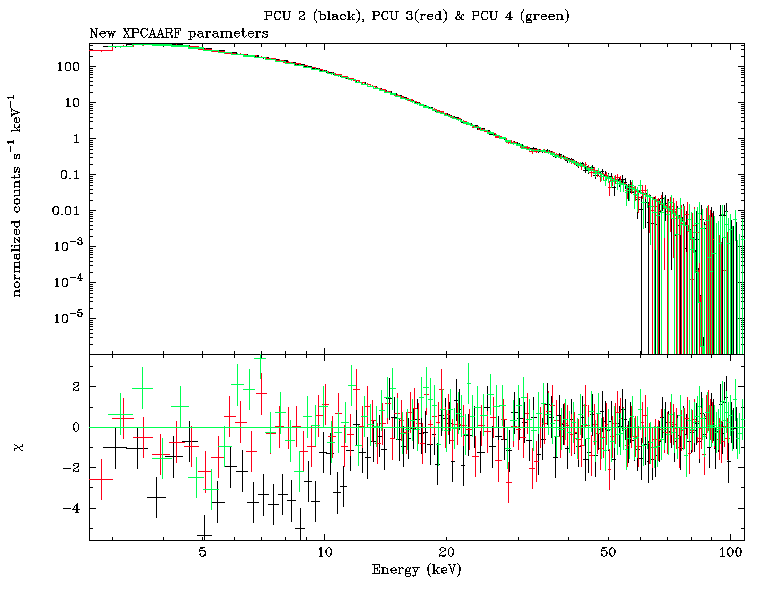|
Revised PCA Effective Area Table of Contents
SummaryThis document describes a revision to the PCA effective area values (so-called "ARF" file). Based on an adjustment to the way that the PCA collimator response is modeled, there are small changes to the effective area, and therefore, small changes to the fitted flux derived from PCA measurements. Observers will see the following change when upgrading from the old version to the new version.
Those people who use PCU2-only will see a 0.4% reduction in fitted fluxes from the same observed data after migrating to the new response matrix. Users will see small changes in fitted flux parameters (~0.5%), and should generally see better agreement between spectra of individual PCUs. The PCA team makes the following recommendations for observers with PCA spectral data:
Where to Download:
IntroductionThe RXTE PCA team continues to improve the calibration of the instrumental response. When performing spectral analysis, users must generate a response matrix for their spectrum. The process to generate a response matrix for PCA observations can be found on the RXTE GOF page entitled, Creating PCA Responses. Recently the PCA team noted a discrepancy in the way that the PCA collimator response was being applied during calibration analysis. BackgroundA response matrix is essentially composed of two elements: the redistribution matrix (RMF) and the effective area curve (ARF). For the RXTE PCA instrument, the RMF is calculated by the software task PCARMF and the ARF is calculated by the software task XPCAARF. A convenience script called PCARSP can be used to create both components with a single command. For the PCA, these two elements are combined into a single response matrix file.
The RXTE PCA instrument consists of a collimator on top of a proportional counter detector (see Figure 1). The collimator is a set of long thin hexagonal tubes. The PCA detector views space through these tubes. Figure 2 shows an example of the view through a hexagonal collimator of a nearby camera. The nearby perspective effect causes some collimator cells to have a blocked view. A distant observer will not have a perspective effect, but if there is even a slight misalignment of the collimator assembly, there will be some blockage of the view by the tilted collimator walls.
The amount of blockage depends on the position of the target. Also, the alignment and response of each of the collimators is slightly different from PCU to PCU, meaning that the PCUs "look" in slightly different direction. The observatory pointing direction - i.e. where the science target is usually located - does not typically fall at the absolute peak collimator response of any PCU. The PCA team has modelled the collimator response of each PCU. The software task XPCAARF uses these models to determine the efficiency for a given observation when making the ARF file. Thus it is important to apply the correct collimator response when performing spectral analysis. More information about the spectral and collimator responses can be found in the paper Jahoda et al. 2006. Problem and SolutionThe PCA team recently noticed that the process that a normal observer would use to compute a response matrix, (i.e. PCARMF + XPCAARF), was not precisely the same way that the response matrix was being computed during calibration analysis. Typically, special software must be used during calibration analysis because multiple parameters must be varied, and different scenarios must be attempted. The small discrepancy involved how the collimator response was evaluated for on-axis sources. The collimator is now applied consistently. The new technique involves only a change to the geometric areas which are stored in the parameter file of the software task XPCAARF. This parameter file is available in HEASOFT version 6.11 and higher. The software itself was not changed. The changes are listed in the following table.
ResultsThe PCA team tested the old and new XPCAARF parameters, using an observation of the Crab nebula. The following two figures show the BEFORE and AFTER residuals for three PCUs.
These spectra show a significant improvement in the 2-10 keV band. The large residual systematic scatter between PCUs which appears in the BEFORE picture are largely removed in the AFTER picture. In other words, the PCUs agree with each other more closely. This is to be expected because the collimator response - which is unique to each PCU - is being applied more correctly. The peak-to-peak residual errors are reduced from about +/-3% in the BEFORE case to about +/-1-1.5% in the AFTER case. The overall response of the 5 PCUs changes by about 0.4% with this update. PCU2, which is commonly analyzed alone, also changes by about 0.4%. As noted above, the primary benefit of this change will be that the individual PCUs agree more closely. Many observers will be insensitive to such a small change in the reported fluxes from their PCA observations. Other observers might be sensitive to a 0.4% relative change from observation to observation, but this change should apply to all observations equally. Users should be aware that the absolute flux calibration of the PCA instrument (in fact all instruments!) is a difficult question to answer. At this time, the PCA team does not have a definitive answer to the absolute flux response of the instrument. Data analyzed with two different sets of software may produce different flux values by approximately 0.4%. The solution is to analyze all data with the same set of software. How to Use the New Response MatrixThe new effective area is available in HEASOFT release 6.11 and later. Users should download this version of the software and install it. The new effective area values are included in the "system" parameter file of the XPCAARF software task. Before running the new version of the software, users should issue the following command, punlearn xpcaarf This should erase any old, locally cached values and load the newest system values. As noted above, a new response matrix must be generated for each spectrum. The magnitude of the effective area change applies equally to observations taken throughout the RXTE mission. ConclusionThe RXTE PCA team generally recommends users to download new software and use it. Users will see small changes in fitted flux parameters (~0.5%), and should generally see better agreement between spectra of individual PCUs. Changes
If you have a question about RXTE, please send email to one of our help desks.
| ||||||||||||||||||||||||||||||||||||||||||||||||||||||


 .
. 

